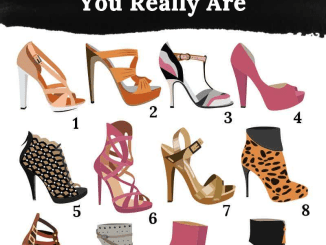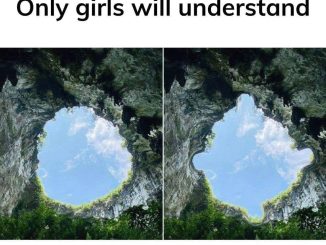Here’s a challenge that might look simple at first, but once you dive in, it will really make your brain work. You’re shown a neat row of colored pencils from the front — all different shapes, sizes, and positions. Your task? Find out what the back-side view would look like.
You’re given five answer options: A, B, C, D, and E. Only one of them is correct. Sounds straightforward, right? But don’t rush — this one tests your ability to visualize and reason spatially. Before scrolling down to the solution, take a moment to truly imagine what those pencils would look like from the other side.

Why Most People Struggle With This Puzzle
This puzzle messes with your perception — and that’s what makes it fun. Here’s why many people get it wrong:
They assume the answer lies in color alone, but it’s not just about matching colors. The key lies in positioning and detail orientation. If you simply try to reverse the order without thinking about each pencil’s specific traits — like which end shows the eraser or the sharpened tip — you’ll likely land on the wrong answer.
Another common mistake? People forget to fully flip the image. When you view something from the back, it’s not just mirrored — certain details, like direction and orientation of angled pencils, also change. That’s where the real challenge lies.
Step-by-Step Guide to Solving the Puzzle
Let’s solve this logically, step by step. First, we’ll identify the details in the front-facing image, then mentally flip the whole lineup to get the correct answer.
Video : Solve These Riddles, and You’re a Math Genius
Step 1: Identify Each Pencil
Looking at the front view, the pencils from left to right appear in this order:
- A black pencil with a sharp point and eraser end toward the back
- A yellow-orange pencil with a sharpened point
- A green pencil with a hexagonal top
- A yellow pencil with both a point and visible eraser
- A white pencil with an eraser top
- A green pencil laid horizontally, pointing left
- A blue pencil standing upright with an eraser on top
Now imagine you walk behind the row of pencils and look at them from the opposite side. You’re going to see the reverse order, like looking in a mirror.
Step 2: Reverse the Order
From the back, the pencil order becomes:
- Blue pencil
- Green horizontal pencil (now pointing right)
- White pencil
- Yellow pencil
- Green hex pencil
- Orange-yellow pencil
- Black pencil
Already, this step helps us eliminate any answer options that don’t reflect this new left-to-right order.
Step 3: Pay Attention to the Details
Now comes the fine-tuning. For the back view, we must consider each pencil’s distinguishing features — sharpened ends, erasers, height, and angle.
- The blue pencil should still show the eraser, now on the left.
- The green horizontal pencil flips direction — it now points right instead of left.
- The white pencil has an eraser — we should see that.
- The yellow pencil has a sharpened tip and an eraser — both are still visible.
- The green hexagonal pencil maintains its flat top.
- The orange-yellow pencil still shows the sharpened tip.
- The black pencil has its eraser now on the far right.
Match this information to the options, and one stands out clearly.
Answer: Option B
Option B shows:
- The pencils in the correct reversed order
- The horizontal green pencil now pointing in the opposite direction
- Erasers and sharpened tips properly switched to reflect the back view
Everything lines up. The shape, positioning, direction, and structure all make Option B the only possible correct choice.

Why This Puzzle Is More Than Just a Visual Game
This isn’t just a fun distraction — it’s also an incredible way to sharpen cognitive skills. Here’s what you’re improving when you solve puzzles like this:
- Spatial reasoning: The ability to manipulate and rotate objects in your mind.
- Attention to detail: Noticing small differences in shape, direction, and orientation.
- Problem-solving: Thinking beyond the obvious and working through a challenge logically.
- Visual memory: Holding images in your mind and comparing them to new inputs.
These skills aren’t just good for solving puzzles — they help in real-life scenarios, from driving and navigation to building and planning.
What Most People Get Wrong
Let’s be honest — a lot of people will confidently pick Option A or D at first glance. Why?
Because they quickly reverse the order without thinking about the direction of the pencils or how erasers and tips appear when flipped. For example, that green pencil lying sideways throws off a lot of guesses because its flipped orientation is so subtle. It’s exactly that kind of tricky detail that separates a guess from a correct answer.
Did You Get It Right? Let Us Know!
So, how’d you do?
- 💡 Did you instantly spot the back-side match?
- 😵 Or did one tiny detail throw you off?
- 🤔 Did you overthink it or go with your gut?
Video : Matchstick Puzzle – Fix The Equation
Drop a comment with your answer before sharing this with your friends and family. You’ll be surprised how many different answers people give — and how confidently they explain them!
Why You Should Keep Playing These Visual Puzzles
If you enjoyed this one, there are dozens of similar challenges out there that test your mind in fun, creative ways. These puzzles are great for:
- Quick mental workouts during breaks
- Boosting focus and memory
- Strengthening pattern recognition
- Sharing something interactive and fun with others
They’re like a gym session for your brain — just way more fun and a lot less sweaty.
Conclusion: See What Others Miss
This puzzle is a perfect example of how sometimes the answer is right in front of us — we just need to look from the right angle. It’s not just about flipping shapes or spotting colors; it’s about training yourself to look deeper, slow down, and really see.
So next time you’re faced with a challenge that seems confusing, ask yourself: what would this look like from another point of view?
Your answer just might change — and so might your perspective.


